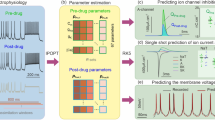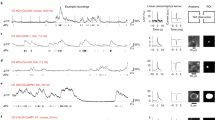Abstract
Dynamic clamp is a powerful method that allows the introduction of artificial electrical components into target cells to simulate ionic conductances and synaptic inputs. This method is based on a fast cycle of measuring the membrane potential of a cell, calculating the current of a desired simulated component using an appropriate model and injecting this current into the cell. Here we present a dynamic clamp protocol using free, fully integrated, open-source software (StdpC, for spike timing-dependent plasticity clamp). Use of this protocol does not require specialist hardware, costly commercial software, experience in real-time operating systems or a strong programming background. The software enables the configuration and operation of a wide range of complex and fully automated dynamic clamp experiments through an intuitive and powerful interface with a minimal initial lead time of a few hours. After initial configuration, experimental results can be generated within minutes of establishing cell recording.
This is a preview of subscription content, access via your institution
Access options
Subscribe to this journal
Receive 12 print issues and online access
$259.00 per year
only $21.58 per issue
Buy this article
- Purchase on Springer Link
- Instant access to full article PDF
Prices may be subject to local taxes which are calculated during checkout



Similar content being viewed by others
References
Robinson, H.P. & Kawai, N. Injection of digitally synthesized synaptic conductance transients to measure the integrative properties of neurons. J. Neurosci. Meth. 49, 157–165 (1993).
Sharp, A.A., O'Neil, M.B., Abbott, L.F. & Marder, E. The dynamic clamp: artificial conductances in biological neurons. Trends Neurosci. 16, 389–394 (1993).
Sharp, A.A., Skinner, F.K. & Marder, E. Mechanisms of oscillation in dynamic clamp constructed two-cell half-center circuits. J. Neurophysiol. 76, 867–883 (1996).
Elson, R.C., Selverston, A.I., Abarbanel, H.D.I. & Rabinovich, M.I. Inhibitory synchronization of bursting in biological neurons: dependence on synaptic time constant. J. Neurophysiol. 88, 1166–1176 (2002).
Szücs, A., Elson, R.C., Rabinovich, M.I., Abarbanel, H.D.I. & Selverston, A.I. Nonlinear behavior of sinusoidally forced pyloric pacemaker neurons. J. Neurophysiol. 85, 1623–1638 (2001).
Nowotny, T., Zhigulin, V.P., Selverston, A.I., Abarbanel, H.D. & Rabinovich, M.I. Enhancement of synchronization in a hybrid neural circuit by spike-timing dependant plasticity. J. Neurosci. 23, 9776–9785 (2003).
Nowotny, T., Szücs, A., Pinto, R.D. & Selverston, A.I. Stdpc: a modern dynamic clamp. J. Neurosci. Meth. 158, 287–299 (2006).
Rothman, J.S., Cathala, L., Steuber, V. & Silver, R.A. Synaptic depression enables neuronal gain control. Nature 457, 1015–1018 (2009).
Netoff, T.I. et al. Synchronization in hybrid neuronal networks of the hippocampal formation. J. Neurophysiol. 93, 1197–1208 (2005).
Selverston, A.I. et al. Reliable circuits from irregular neurons: a dynamical approach to understanding central pattern generators. J. Physiol. Paris. 94, 357–374 (2000).
Szücs, A., Berton, F., Nowotny, T., Sanna, P. & Francesconi, W. Consistency and diversity of spike dynamics in the neurons of bed nucleus of stria terminalis of the rat: a dynamic clamp study. PLoS ONE 5, e11920 (2010).
Szücs, A., Vehovszky, A., Molnar, G., Pinto, R.D. & Abarbanel, H.D.I. Reliability and precision of neural spike timing: Simulation of spectrally broadband synaptic inputs. Neuroscience 126, 1063–1073 (2004).
Szücs, A., Huerta, R., Rabinovich, M.I. & Selverston, A.I. Robust microcircuit synchronization by inhibitory connections. Neuron 61, 439–453 (2009).
Kros, C.J., Ruppersberg, J.P. & Rüsch, A. Expression of a potassium current in inner hair cells during development of hearing in mice. Nature 394, 281–284 (1998).
Oltedal, L., Veruki, M.L. & Hartveit, E. Passive membrane properties and electrotonic signal processing in retinal rod bipolar cells. J. Physiol. 587, 829–849 (2009).
Desai, N.S. & Walcott, E.C. Synaptic bombardment modulates muscarinic effects in forelimb motor cortex. J. Neurosci. 26, 2215–2226 (2006).
Kinard, T.A., de Vries, G., Sherman, A. & Satin, L.S. Modulation of the bursting properties of single mouse pancreatic beta-cells by artificial conductances. Biophys. J. 76, 1423–1435 (1999).
Bertram, R., Previte, J., Sherman, A., Kinard, T.A. & Satin, L.S. The phantom burster model for pancreatic beta-cells. Biophys. J. 79, 2880–2892 (2000).
Watanabe, E.I., Honjo, H., Anno, T., Boyett, M.R., Kodama, I. & Toyama, J. Modulation of pacemaker activity of sinoatrial node cells by electrical load imposed by an atrial cell model. Am. J. Physiol. 269, H1735–H1742 (1995).
Wilders, R. et al. Action potential conduction between a ventricular cell model and an isolated ventricular cell. Biophys. J. 70, 281–295 (1996).
Berecki, G. et al. HERG channel (dys)function revealed by dynamic action potential clamp technique. Biophys. J. 88, 566–578 (2005).
Wheeler, D.W., Kullmann, P.H. & Horn, J.P. Estimating use-dependent synaptic gain in autonomic ganglia by computational simulation and dynamic-clamp analysis. J. Neurophysiol. 92, 2659–2671 (2004).
Horn, J.P. & Kullmann, P.H. Dynamic clamp analysis of synaptic integration in sympathetic ganglia. Neirofiziologiia 39, 423–429 (2007).
Muñiz, C., Levi, R., Benkrid, M., Rodríguez, F.B. & Varona, P. Real-time control of stepper motors for mechanosensory stimulation. J. Neurosci. Meth. 172, 105–111 (2008).
Chamorro, P., Levi, R., Rodriguez, F.B., Pinto, R.D. & Varona, P. Real-time activity-dependent drug microinjection. BMC Neurosci. 10, 296 (2009).
Prinz, A.A., Abbott, L.F. & Marder, E. The dynamic clamp comes of age. Trends Neurosci. 27, 218–224 (2004).
Goaillard, J.-M. & Marder, E. Dynamic clamp analyses of cardiac, endocrine, and neural function. Physiology 21, 197–207 (2006).
Economo, M.N., Fernandez, F.R. & White, J.A. Dynamic clamp: alteration of response properties and creation of virtual realities in neurophysiology. J. Neurosci. 30, 2407–2413 (2010).
Destexhe, A. & Bal, T. (eds.) Dynamic Clamp: From Principles to Applications (Springer, 2009).
Wilders, R. Dynamic clamp: a powerful tool in cardiac electrophysiology. J. Physiol. 576, 349–359 (2006).
Pinto, R.D. et al. Extended dynamic clamp: controlling up to four neurons using a single desktop computer interface. J. Neurosci Meth. 108, 39–48 (2001).
Song, S., Miller, K.D. & Abbott, L.F. Competitive Hebbian learning through spike-timing-dependent synaptic plasticity. Nat. Neurosci. 3, 919–926 (2000).
Abarbanel, H.D.I., Huerta, R. & Rabinovich, M.I. Dynamical model of long-term synaptic plasticity. Proc. Natl. Acad. Sci. USA 99, 101–136 (2002).
Brette, R. et al. High-resolution intracellular recordings using a real-time computational model of the electrode. Neuron 59, 379–391 (2008).
Brette, R., Piwkowska, Z., Rudolph, M., Bal, T. & Destexhe, A. A non-parametric electrode model for intracellular recording. Neurocomput. 70, 1597–1601 (2007).
Company of Biologists. Microelectrode Techniques: the Plymouth Workshop Handbook (eds. Standen, N.B., Gray, P.T.A., & Whitaker, M.J., Company of Biologists, 1987).
Molecular Devices. The Axon Guide: a Guide To Electrophysiology & Biophysics Laboratory Techniques, Technical Report, Analytical Technologies, http://files.axon.com/downloads/manuals/Axon_Guide.pdf (2008).
Staras, K., Gyóri, J. & Kemenes, G. Voltage-gated ionic currents in an identified modulatory cell type controlling molluscan feeding. Eur. J. Neurosci. 15, 109–119 (2002).
Traub, R.D. & Miles, R. Neuronal Networks of the Hippocampus (Cambridge University Press, 1991).
Banker, G. & Goslin, K. Culturing Nerve Cells (MIT Press, 1998).
Branco, T., Staras, K., Darcy, K.J. & Goda, Y. Local dendritic activity sets release probability at hippocampal synapses. Neuron 59, 475–485 (2008).
Hamill, O.P., Marty, A., Neher, E., Sakmann, B. & Sigworth, F.J. Improved patch clamp techniques for high-resolution current recording from cells and cell-free membrane patches. Pflügers Arch. 391, 85–100 (1981).
Dorval, A.D., Christini, D.J. & White, J.A. Real-time linux dynamic clamp: a fast and flexible way to construct virtual ion channels in living cells. Ann. Biomed. Eng. 29, 897–907 (2001).
Butera, R.J. Jr., Wilson, C.G., DelNegro, C.A. & Smith, J.C. A methodology for achieving high-speed rates for artificial conductance injection in electrically excitable biological cells. IEEE Trans. Biomed. Eng. 48, 1460–1470 (2001).
Culianu, C.A. & Christini, D.J. Real-time Linux experiment interface system: RTLab. Proceedings of the IEEE 29th Annual Northeast Bioengineering Conference, Newark, New Jersey, USA. 51–52 (2003).
Bettencourt, J.C., Lillis, K.P., Stupin, L.R. & White, J.A. Effects of imperfect dynamic clamp: computational and experimental results. J. Neurosci. Meth. 169, 282–289 (2008).
Preyer, A.J. & Butera, R.J. Causes of transient instabilities in the dynamic clamp. IEEE Trans. Neural Syst. Rehabil. Eng. 17, 190–198 (2009).
Kullmann, P.H.M., Wheeler, D.W., Beacom, J. & Horn, J.P. Implementation of a fast 16-bit dynamic clamp using LabVIEW-RT. J. Neurophysiol. 91, 542–554 (2004).
Robinson, H.P.C. A scriptable DSP-based system for dynamic conductance injection. J. Neurosci. Meth. 169, 271–281 (2008).
Milescu, L.S., Yamanishi, T., Ptak, K., Mogri, M.Z. & Smith, J.C. Real-time kinetic modeling of voltage-gated ion channels using dynamic clamp. Biophys. J. 95, 66–87 (2008).
Muñiz, C., Rodriguez, F.B. & Varona, P. RTBiomanager: a software platform to expand the applications of real-time technology in neuroscience. BMC Neurosci. 10, 49 (2009).
Acknowledgements
T.N. is indebted to R.D. Pinto for the initial development work of Dynclamp 2/4, the early predecessor of StdpC, and to A. Szücs for years of testing StdpC. This work was financed partially by an RCUK fellowship to T.N. The work also received financial support from an MRC research grant held by G.K. and from BBSRC and Wellcome Trust research grants held by K.S.
Author information
Authors and Affiliations
Contributions
I.K. set up preparations and designed and conducted the electrophysiological experiments using invertebrate neurons, V.M. set up preparations, designed and conducted electrophysiological experiments using vertebrate neurons and designed figures, M.C. contributed to the electrophysiological experiments using invertebrate neurons, D.S. worked on the software and drafted parts of the manuscript, K.S. designed and supervised vertebrate experimentation and wrote the manuscript, G.K. designed and supervised the experiments using invertebrate neurons and T.N. developed the method and software, wrote the manuscript, produced the supplementary movies, established dynamic clamp at Sussex together with G.K. and coordinated the whole effort. All authors were involved in revising the manuscript.
Corresponding author
Ethics declarations
Competing interests
The authors declare no competing financial interests.
Supplementary information
Supplementary Video 1: Introduction to the dynamic clamp hardware and setup.
This short movie introduces the main hardware components used in a dynamic clamp experiment with StdpC. Thomas Nowotny and Michael Crossley introduce the hardware (electrophysiology rig, amplifier, data acquisition, dynamic clamp data acquisition board), the Lymnaea preparation, and an example of a pattern clamp experiment. (MOV 44750 kb)
Supplementary Video 2: StdpC user interface and configuration
This video gives a brief introduction into how to use the StdpC graphical user interface and how to configure StdpC. We cover general configuration, configuring input and output channels and how to configure a typical simulated chemical synapse. (MOV 23826 kb)
Supplementary Equations: Equations describing the K+ conductance introduced in the Anticipated Results (see also Fig. 3 B).
The supplementary equations described in this supplement define a delayed rectifier potassium current following the model of a hippocampal cell given in ref 48. (PDF 17 kb)
Supplementary Methods: Reagents and solutions used for the Anticipated Results.
In this supplement we provide the details on the reagents and the exact solutions used in the Anticipated Results. Solutions are described for Lymnaea saline, hippocampal bath solution, sharp electrode internal solution and patch electrode internal solution. (PDF 79 kb)
Supplementary Fig. 1: Details of EPSPs and EPSCs of the simulated synaptic conductance shown in Fig. 3A.
A) EPSPs for simulated maximal synaptic conductance of 10, 20, 30, 50, 80, 120, 170, 230, 300, 390, 490, and 600 nS aligned to the occurrence of the pre-synaptic spike. For each maximal conductance, 5 individual EPSPs (grey lines) and their average (colored lines) are shown. The other parameters were as in Fig. 3A, i.e. Vrev= 0 mV, tausyn= 10 ms, and Vslope= 25 mV. (PDF 724 kb)
B) Corresponding EPSCs. The colors of A and B are matched to mark the corresponding data sets.
Animal care and use protocols complied with Home Office (UK) guidelines.
Rights and permissions
About this article
Cite this article
Kemenes, I., Marra, V., Crossley, M. et al. Dynamic clamp with StdpC software. Nat Protoc 6, 405–417 (2011). https://doi.org/10.1038/nprot.2010.200
Published:
Issue Date:
DOI: https://doi.org/10.1038/nprot.2010.200
This article is cited by
-
Automatic Adaptation of Model Neurons and Connections to Build Hybrid Circuits with Living Networks
Neuroinformatics (2020)
-
Analogue modulation of back-propagating action potentials enables dendritic hybrid signalling
Nature Communications (2016)
-
Temporal synchrony and gamma-to-theta power conversion in the dendrites of CA1 pyramidal neurons
Nature Neuroscience (2013)
Comments
By submitting a comment you agree to abide by our Terms and Community Guidelines. If you find something abusive or that does not comply with our terms or guidelines please flag it as inappropriate.



